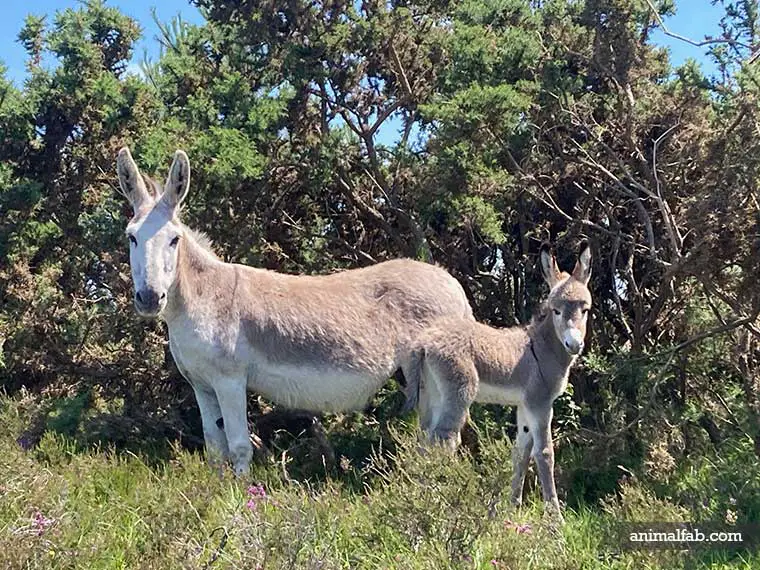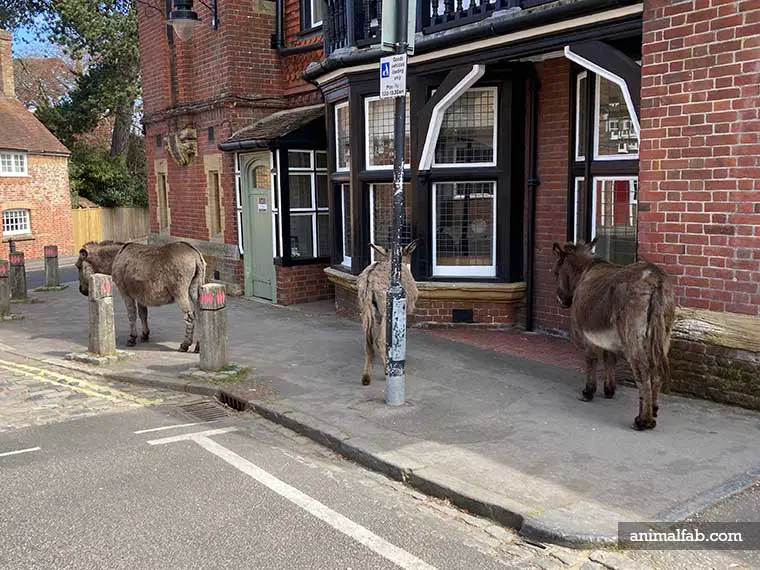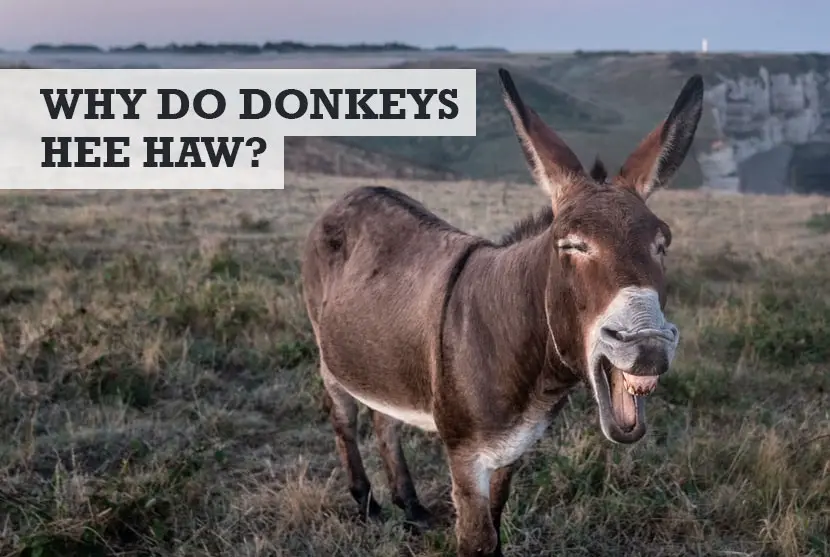If you’ve owned a donkey, lived near a donkey, or simply been close to a donkey, you can’t help but notice how much the bray or hee haw when trying to communicate something. But the reasons why donkeys hee haw and bray and multi-faceted as I will explain today… here’s a quick 101 on donket communication.
Why do donkeys hee haw and bray?
There are many reasons why donkeys bray. As sociable and vocal animals that, despite their stoic appearances, they want to express a range of emotions, and this is achieved using the hee haw or braying sound.
Donkey hee haws and brays can sound welcoming, mournful or just plain comical.
Primarily their considerable vocal ability is used to communicate basic needs, such as:
- Braying to express a need for companionship.
- Braying because they are hungry.
- Braying to warn of danger to them or others.
- Braying due to being in distress (perhaps cold).
- Braying to announce the search for a mate.
Donkeys will also hee haw at night. I’ve previously written in depth about this habit, so please check out this article about night-time braying.

The origin of the hee haw and bray
Since prehistoric times, donkeys have roamed the desert and scrub land regions of North Africa. They travelled in herds and used their loud braying to communicate with each other and to maintain contact, across wide open spaces.
Their natural environment was dangerous, with threats from wolves, lions and other feline and canine predators. The donkey alarm call needed to be raucous enough to ward off predators and to warn others in the herd of the danger.
To match their vocal prowess, they developed large ears to act as antennae or receivers.
The characteristics of a bray and hee haw
Although the historic need for a deafening communication strategy has largely disappeared, donkeys are as loud as ever. Their brays have been measured at around 80 decibels and it is suggested that, under the right conditions, they can be heard up to 60 miles away.
This may not be desirable if you are thinking of keeping a donkey as a pet in a residential area. The worst case scenario is that they start singing in concert.
The bray, otherwise known as hee-haw, is produced on the intake and outflow of breath, and both the mouth and nose are involved in producing the sound. The whole body rocks on occasion, depending on the intensity of emotion behind the call.
Although they seem mechanical and repetitive, each bray usually has a beginning, middle and end. You can sense when it about to start. It winds up and gets louder and louder, until the donkey is in full cry. Then it stops, seemingly when the animal has run out of breath.
Donkeys of all ages, breeds and sizes bray, but some are more vocal than others, especially the males. Each donkey has its own distinctive signature tune, which varies in frequency, tone, pitch and duration. Some even say ‘haw-hee’, instead of ‘hee-haw’.
Modern donkeys that hee haw and bray
For the past two thousand years, donkeys have been domesticated. They were kept by subsistence farmers as beasts of burden, often living at close quarters with their owners. They appeared stoic and sombre as they trudged along, heavily laden or pulling carts, and were trained to accept their lot. They were discouraged from using their voices.
Since the advent of motorised vehicles, there has been a sharp decline in employment opportunities for donkeys, and many have been surrendered to shelters and sanctuaries. Keeping a donkey as a pet has also become an increasing trend.

Why modern donkeys like to hee haw
Donkey personalities have been observed and studied in a variety of settings, and it has emerged that they bray to express a range of needs and emotions
1. Companionship
In the Chinese culture, a bray is a symbol of ritualism and friendship.
Donkeys have individual personalities, like humans, dogs and many species. Some are more sociable than other but most feel the need for companionship and trust. They call out for company, whenever the mood strikes them, and even strike up long distance conversations.
Donkeys can bray, almost from birth. Orphaned donkeys have been known to call consistently for their mothers until they have someone or something else to bond with.
If you have a solo donkey, it may realise it is alone in the middle of the night, and start braying. If you have neighbours within a 60 mile radius, complaints could follow.
To some extent, their need for companionship can be satisfied by meaningful bonds with people or other barn animals. First prize, for the donkey, is another donkey. Depending on space, you may consider keeping a small herd.
Interestingly, donkeys can also like human companionship. A donkey might hee haw to get the owners attention as a way of showing affection.
2. Hunger
Donkeys are browsers and the best food for them is low in nutrition. They have slow digestive systems that can harness the energy in marginal vegetation. They need to feed often, on fibre rich plants.
Their stomach alarms go off if they are not fed regularly, and they let the world know with loud protests. To prevent these tirades, feed them at scheduled times so that they can feel secure about their food source. If space allows, let them roam in an area where the vegetation is ideal for their diet.
3. Danger
Because of their fearless nature, donkeys are often used as early warning systems to keep other farm and barn animals safe. Loud braying will scare off most predators but if that does not work, the donkey will confront a predator rather than try to flee.
Donkeys will also bare their teeth when threatened, which is a sign for humans to back away quickly.
To prevent unnecessary braying, install movement-sensitive lighting on the perimeter of the barn area to ward off nocturnal predators before they alert the donkey.
4. Distress
There are a number of reasons that your donkey may be feeling distressed. It could be lonely or feeling angry or frustrated at being cooped up in a small space. On a more serious note, the donkey may be ill or in pain.
In order to understand what your donkey is trying to communicate observe, its habits and body language.
If you have a small group of donkeys and they start singing the song of their people at 5 am every morning, clearly this is not an indication of real distress. They are trying to train you to let them out at their command.
Donkeys are known for their stoicism, and seldom complain when they are genuinely in distress. Look for changes in behaviour, such as a lack of appetite or general listlessness.
5. Mating
Male donkeys are more vocal than females. Among other things, they use their brays to sweet talk the females during courtship. It is part of the pre-mating ritual.
In the wild, donkeys live in herds comprising one dominant male, and several females. Would be contenders for the affections of the females are seen off by the dominant male, and forced to wander round in the desert as bachelors until they can establish their own herd.
A dominant male can control a territory of about 9 square miles. He warns off other suitors by marking the perimeter and by braying.
Unless you have the knowledge and the environment in which to breed donkeys, it is best to have them neutered if you are keeping them as pets. This should cut down on most of the male vocals.
6. Communicating with humans
Donkeys are intelligent creatures and will soon realise that a human can do things for it that donkeys and other animals cannot. They will use their charm and considerable vocal appeal to train you to do things for them.
I have fallen into this trap. On a guest farm I visited for a few days, the resident donkey would wake the guests for treats each morning. This is a novelty for a few days but as a rule, it is not desirable in a built up area.
Also, donkeys should follow a strictly controlled diet else they put on weight and could become ill.
Some donkeys will run to greet their owners with shouts of glee. Other owners have trained their pets to converse, and even sing with them.
Conclusion
Donkeys bray and hee haw to communicate all types of different emotions and feelings.
A simple bray won’t be enough for you to understand why they are doing it, instead you will need to monitor their environment and body language to check for other signals.
You might also like…
- Why donkeys despise dogs so much
- The top speed of a donkey
- The truth about donkeys and horses cross-breeding
Image in header via https://unsplash.com/photos/Ids_FrpfhEA

